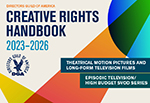
|

Jonathan Mostow
|

Christopher Nolan
|

Thomas Schlamme
|

Nicole Kassell
|
Dear Colleague,
This book is for you.
Since the inception of the DGA in 1936, protecting your creative rights as a Director has been core to our mission as a labor union. From establishing the right to a Director’s Cut, to the many additional hard-fought creative rights protections negotiated over the past 80-plus years, your Guild stands ready and willing to defend these rights on your behalf.
It is critically important for every member to understand the creative rights that are available to us, and to exercise these rights with every production. When we do not exercise them, we actively contribute to their erosion and increase the chance they are not provided to us or other Directors in the future.
Unfortunately, sometimes Directors are either unclear or unaware of the contractual rights we have as DGA members – and we cannot rely on outside individuals or productions to inform us. That’s why we have developed this CREATIVE RIGHTS HANDBOOK – to clearly outline your creative rights throughout all phases of feature film and television production.
This edition contains two separate sections, outlining in detail the creative rights you have and specific issues you may face in Theatrical Motion Pictures and Long-Form Television Films/SVOD and in Episodic Television and High Budget SVOD/AVOD Series.
As you enjoy the benefits of DGA creative rights on your next directing assignment, don’t forget the Directors who have fought battle after battle to win and maintain these contractual protections for us all. You are responsible for contributing to this legacy.
If you find yourself with any creative rights questions or problems, please contact the DGA immediately by calling the DGA Creative Rights Hotline (310) 289-5355 or emailing CreativeRights@dga.org. The Guild is here to help you.
Sincerely,
Jonathan Mostow
Christopher Nolan
Co-Chairs, DGA Creative Rights Committee
Thomas Schlamme
Nicole Kassell
Chair & Co-Chair DGA Television Creative Rights Committee
DIRECTOR'S CUT
The companies feared a "Director's Cut" would mean increased post-production costs. Capra proposed that the companies and the DGA draw up a list of the top 12 Directors in the world. In the event that any Director held up post-production in the way that the companies feared, the Guild, at its own expense, would fly in any one of those Directors from anywhere in the world to finish that work, even if it was only a half-hour TV show. Impressed by the sincerity of the proposal, the studio heads agreed that the Director is entitled to prepare his or her cut of the film.
"The difficulty arose because the only right we had in the contract back then in the early '60s was to make suggestions for improvements in a 'rough cut' to the associate producer. We called many directors together and all of them agreed that they were having similar problems. So we met under the supervision of Joe Youngerman over a period of time to see if we could draft what we called a 'Bill of Creative Rights.' George Sidney, who was President of the Guild at the time, asked Frank Capra to chair a special negotiating committee to obtain acknowledgment of these rights. And that's how it started."
– Elliot Silverstein, original member of the 1964 DGA Creative Rights Committee and Chairman from 1968–1992.
"We gotta show 'em how much we care!"
– Frank Capra, first Chairman of the DGA Creative Rights Committee, recommending to his directorial colleagues in 1964 the way to convince studio heads that directors should be entitled to a "Director's Cut."